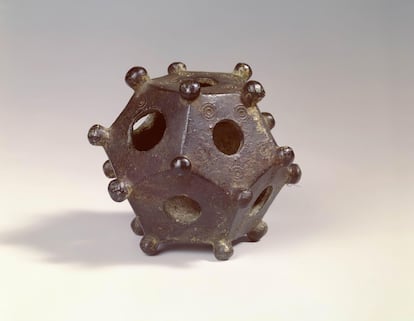Weapons, mystical devices or candle-holders? The mystery of the Roman dodecahedra
Around 120 metallic objects of imprecise origin have puzzled and fascinated archeologists since 1739, and no definitive explanation for their purpose has yet been uncovered

It is a small bronze piece, no bigger than a billiard ball. A 12-sided polyhedron that, at each vertex, has a small round top, like a sphere. A hole is carved into each of its sides, and each of these is a different size. It sounds mysterious, precisely because it is. It is not even known for certain if the so-called Roman dodecahedra originated in Rome. No written reference alludes to them, which makes it very difficult to interpret what place they occupied in the society it is assumed created them.
The dodecahedra were discovered at the beginning of the 18th century and presented to the world in 1739. As confirmed by archaeologist Néstor F. Marqués, around 120 have appeared to date. “Those, plus others that may be in private collections and of which we are not aware. This is not a common object, but it is not rare either,” says Marqués, the author of a book on the rites and rituals of Ancient Rome. After studying the dozens of theories that have been written about the dodecahedra over the past 300 years, the historian harbors at least some certainty: they were not merely decorative objects, because of the precision with which they were cast. “And what were the different-sized holes for?” he adds. Marqués points out another important point: the meaning attached to these objects throughout history speaks more about us than about them.
“At first, it was thought that they might be weapons or some other accessory of war, such as part of a banner. In the late 19th and early 20th centuries it was believed, for example, that the holes might measure the trajectory of a projectile. But this reflects, more than anything else, the interests of historians at the time. Military archaeology was abundant and everything found tended to be focused that way,” says Marqués. Needless to say, it was Europe where those theories were formulated. Most of the pieces have been found in present-day France, Germany and Great Britain: Gaul, Germania and Britannia. As such, there are those who have put forward the theory that the Roman dodecahedron is of Celtic origin: none of these objects have appeared in Italy, North Africa or the Iberian Peninsula, some of Ancient Rome’s key territories.

Could they be mystical objects? Quite possibly. “In the symbolism of Pythagoras and Plato, polyhedra carry a lot of significance. The tetrahedron symbolizes fire and the octahedron, air. The icosahedron, a 20-sided figure, represents water. The hexahedron is the earth. In this sense, the dodecahedron could allude to the whole, to what encompasses them all; the universe. It is an interesting theory, but difficult to prove. There are no marks that refer to the cosmos or the measurement of the stars on these objects,” notes Marqués. Although they are still being found today, the mystery surrounding the dodecahedra endures. In the late 1980s, a dodecahedron was found in Germany in a tomb belonging to a woman. An amulet? Perhaps. Traces of wax were detected next to it. “Were they used to hold candles, then? It seems unlikely,” the historian says. “It has also been suggested that they were measuring instruments, but there are dodecahedrons of very different sizes. At the same time, the difference in the size of the holes does not seem to follow any pattern.”
At this point, so-called experimental archaeology comes into play: adventurers who have created Roman dodecahedrons thanks to three-dimensional printers. The era of social networks did the rest. Some YouTube videos suggest they could be used for weaving: the small pivots at the vertices would help tighten the thread and the holes used to create shapes with the stitch, such as the fingers of a glove. “Some people have already ruled this out, but an interesting door has been opened: the purely domestic one. Perhaps they could be used for games, although they don’t look much like dice,” Marqués points out.
Some far-fetched theories have developed around the dodecahedra, such as that they do not even belong to the time and space where they were found: “Refuting theories always helps to forge a critical spirit. The fundamental thing is that we continue to study history, to review how it has been told up to now and with what interests in mind. And that we continue to find new pieces, always in a scientific context,” says Marqués, alluding to the phenomenon of so-called archaeological plundering. That is to say, that any individual armed with a metal detector can find a dodecahedron at random, without following any kind of procedures to date it and place it accurately.
More mysterious Roman objects
Roman dodecahedrons are not the only objects historians are unable to fully explain. Pedro Huertas, an expert in Roman military archaeology and a museum guide, mentions the betilos, a kind of prehistoric idol with an elongated shape: “There are some who attributed them to sacred sexual rites, but many theories go in different directions.” His favorite enigma is the Antikythera mechanism, discovered in Greece a century ago. This multi-piece artifact is in some ways reminiscent of the wheel used to open a ship’s hatch; it also resembles the mechanism found inside a watch. Curiously, experimental archaeology uncovered its true purpose a year ago: it was used to predict eclipses.
For his part, Marqués points to the baths of Caracalla, in Rome. There, mystery surrounded an ashlar construct with holes, which turned out to be used to place the pieces of a game the Romans liked to play to entertain themselves while bathing. On the other hand, four small holes in the counter of a caupona (inn) in Pompeii still remain unexplained. Were they used by the owner to store change? And what was the purpose of spintriae, Roman tokens on which erotic drawings were minted? “Today, we know that they are more related to public shows than to prostitution. Initially, it was thought that they were tokens used to pay in the brothels,” says Marqués. Again, these interpretations speak less about the objects studied than about ourselves.
Sign up for our weekly newsletter to get more English-language news coverage from EL PAÍS USA Edition
Tu suscripción se está usando en otro dispositivo
¿Quieres añadir otro usuario a tu suscripción?
Si continúas leyendo en este dispositivo, no se podrá leer en el otro.
FlechaTu suscripción se está usando en otro dispositivo y solo puedes acceder a EL PAÍS desde un dispositivo a la vez.
Si quieres compartir tu cuenta, cambia tu suscripción a la modalidad Premium, así podrás añadir otro usuario. Cada uno accederá con su propia cuenta de email, lo que os permitirá personalizar vuestra experiencia en EL PAÍS.
¿Tienes una suscripción de empresa? Accede aquí para contratar más cuentas.
En el caso de no saber quién está usando tu cuenta, te recomendamos cambiar tu contraseña aquí.
Si decides continuar compartiendo tu cuenta, este mensaje se mostrará en tu dispositivo y en el de la otra persona que está usando tu cuenta de forma indefinida, afectando a tu experiencia de lectura. Puedes consultar aquí los términos y condiciones de la suscripción digital.
More information
Últimas noticias
There is as much life left to discover on planet Earth as that which is already known
Dozens presumed dead, around 100 injured in fire at Swiss Alps bar during New Year’s celebration
Is porn for women different from conventional porn? We spoke to those who make it
Cartagena de Indias is sinking: What can the city do to mitigate it?
Most viewed
- David King, chemist: ‘There are scientists studying how to cool the planet; nobody should stop these experiments from happening’
- Reinhard Genzel, Nobel laureate in physics: ‘One-minute videos will never give you the truth’
- Oona Chaplin: ‘I told James Cameron that I was living in a treehouse and starting a permaculture project with a friend’
- Sinaloa Cartel war is taking its toll on Los Chapitos
- The Interoceanic Train, the Mexican alternative to the Panama Canal










































